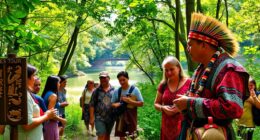When wildlife viewing in Gros Morne National Park, remember to respect the animals and their space. Keep a safe distance, use telephoto lenses for photography, and avoid disturbing their natural behaviors. Early mornings and late afternoons are best for bird watching, so plan your outings accordingly. Practice patience and enjoy quietly observing the diverse species around you. If you want to understand more about enhancing your experience, there’s plenty more to uncover.
Key Takeaways
- Respect wildlife by keeping a safe distance and avoiding disturbances to their natural behaviors.
- Use binoculars or telephoto lenses for observing and photographing wildlife from afar.
- Visit during early mornings or late afternoons for the best bird watching opportunities.
- Follow the principle of ‘leave no trace’ to preserve the habitat for future visitors.
- Educate yourself about local species to enhance your wildlife viewing experience responsibly.

When you venture into Gros Morne National Park, it’s essential to remember that you’re a guest in the animals’ home. Respecting their space and understanding their behavior not only enhances your experience but also contributes to the preservation of their habitat. As you explore the park, keep in mind some vital wildlife viewing etiquette that will help you enjoy the diverse flora and fauna while minimizing your impact.
One of the best ways to appreciate the wildlife in Gros Morne is through bird watching. To make the most of your experience, follow some bird watching tips that will improve your chances of spotting and enjoying these beautiful creatures. First, choose the right time of day. Early mornings and late afternoons are often the most active times for birds, so plan your outings accordingly. Bring a pair of binoculars to help you see birds from a distance without disturbing them. Learn to identify local species by studying field guides or using bird identification apps. This knowledge will enrich your experience and help you appreciate the diversity around you.
Enhance your Gros Morne experience by bird watching during early mornings or late afternoons, equipped with binoculars and knowledge of local species.
When it comes to photography, adhering to photography guidelines is key to capturing stunning images while remaining respectful to wildlife. Always keep a safe distance from animals, as approaching them can cause stress or alter their natural behaviors. Use a telephoto lens to zoom in on your subjects without getting too close. This way, you can preserve the integrity of their environment while still getting the shots you desire. Be patient and wait for the perfect moment; rushing can result in missed opportunities and can disturb the animals.
Consider the time of day for your photography as well. The golden hours of sunrise and sunset provide soft, flattering light that makes for beautiful images. Avoid using flash, which can startle animals and ruin their experience. Instead, focus on capturing the essence of the wildlife and their surroundings in a way that tells a story without intruding upon their lives.
In Gros Morne National Park, you have the privilege to witness nature’s wonders. By following these bird watching tips and photography guidelines, you not only enhance your experience but also show respect for the delicate balance of life in this remarkable ecosystem. Remember to tread lightly and leave no trace, ensuring that future visitors can enjoy the same beauty you did.
Frequently Asked Questions
What Are the Best Times for Wildlife Viewing in Gros Morne?
The best times for wildlife viewing in Gros Morne are during dawn and dusk. Animals are most active during these hours, making your chances of spotting them much higher. Additionally, keep an eye on seasonal migration patterns; many species travel through the area at specific times of the year. By planning your visits around these periods, you’ll enhance your experience and have a better chance of encountering the diverse wildlife that inhabits the park.
Are There Any Specific Animals to Watch for in the Park?
In Gros Morne National Park, you’ll want to keep an eye out for moose, caribou, and beavers during your visit for some exciting mammal sightings. Birdwatching hotspots like the coastlines and wetlands attract various species, including puffins and ospreys. Early mornings or late afternoons are your best chances to spot these animals, so grab your binoculars and enjoy the incredible wildlife this beautiful park has to offer!
Can I Bring My Pet While Wildlife Viewing?
Sure, you can bring your pet along, but let’s be real—your dog’s not exactly a wildlife whisperer. Park regulations require you to keep pets leashed and at a safe distance from wildlife. Remember, it’s all about pet safety and protecting those adorable critters. So, unless your pet’s a trained animal ambassador, it’s probably best to leave them at home while you enjoy the park’s natural wonders.
What Should I Do if I Encounter a Bear?
If you encounter a bear, stay calm and don’t approach it. Make noise to alert the bear of your presence, but avoid yelling or sudden movements. Back away slowly, keeping the bear in sight. Remember bear safety guidelines: never run or climb a tree, as this may provoke a chase. If the bear approaches, stand your ground and use bear spray if necessary. Always follow visitor precautions to guarantee your safety and that of the bear.
Are There Guided Tours Available for Wildlife Viewing?
Imagine beginning a magical journey through a forest alive with creatures, where guided tour options await you. Yes, there are guided tours available for wildlife viewing! You’ll join expert guides who know the land’s secrets, pointing out fascinating wildlife along the way. They’ll share stories that breathe life into the surroundings, making your adventure unforgettable. So, grab your gear, and let these wildlife experts lead you to nature’s wonders.
Conclusion
As you set out on your wildlife viewing journey in Gros Morne National Park, remember to tread lightly, like a whisper on the wind. Respect the animals’ home, giving them space to roam freely, just as you would want your own sanctuary protected. By following these simple guidelines, you’ll not only preserve the park’s beauty but also create lasting memories that shimmer like sunlight on a tranquil lake. So, keep your heart open and your actions mindful—nature’s wonders await!










